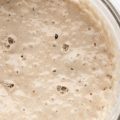Maintaining a sourdough starter through times where you don’t plan to bake can be quite unnecessary and a waste of flour. Learning how to store sourdough starter properly can further assist your future plans of sourdough baking in no time, without having to commit to baking every single day.
Before making sourdough bread first you need a healthy sourdough starter. And proper way of storing sourdough starter is one of the things you should learn. With those tips from us, baking sourdough bread will be easy as walking in the park.
There are a few ways to store your sourdough starter, depending on how long you wish to put it away for, and how you plan to revive it, as well as the way you will need to maintain it during its time remaining in storage.
So if you’re wondering how long your sourdough starter will last when stored and temporarily forgotten, then let’s jump right into it!

Table of Contents
- What is Sourdough Starter?
- Factors Affecting Sourdough Starter Longevity
- How to Store Sourdough Starter?
- Signs of a Healthy Sourdough Starter
- Feeding Sourdough Starter
- How Long Can Sourdough Starter Last at Room Temperature?
- When is Your Starter Ready for the Fridge?
- Long-Term Starter Maintenance
- Reviving a Dormant or Weak Starter
- Common Starter Problems
- So, How Long Does Sourdough Last?
- FAQs
What is Sourdough Starter?
Sourdough starter, also known as a sourdough culture or leaven, is a mixture of flour and water that has been left to ferment. It contains wild yeast and lactic acid bacteria. This combination is what allows you to use sourdough starter instead of commercial yeast in your breads, giving sourdough bread a unique flavor profile.
Comparing Sourdough Starter Longevity
- Rye flour contains abundant nutrients that wild yeast and bacteria thrive on. As a result, rye starters typically activate faster and maintain their vitality longer between feedings. They tend to ferment rapidly.
- Wheat starters, made with all-purpose or bread flour, are versatile. Wheat starters ferment at a more moderate pace compared to rye, making them more forgiving if you occasionally miss a feeding.
- Alternative grain starters can be less predictable. They may require more attention.
In terms of durability, rye starters often perform exceptionally well. Wheat starters offer good stability, while alternative grain starters might require more frequent attention to maintain their activity.
Factors Affecting Sourdough Starter Longevity
Temperature: The Ideal Range
Temperature plays a crucial role in sourdough starter longevity. Too high, and the yeast becomes overactive, consuming nutrients too quickly. Too low, and the microorganisms become sluggish. The optimal temperature range is room temperature, around 68-72°F (20-22°C). Maintaining your starter within this range promotes a healthy, long-lasting culture.
Feeding Frequency: Finding the Right Schedule
Regular feeding is essential for a thriving sourdough starter. The frequency of feeding depends on storage conditions. A starter kept at room temperature typically requires daily feedings, while one stored in the refrigerator can be fed weekly. Establishing the right feeding schedule is key to maintaining a viable starter over time.
Flour Types: Choosing the Right Ingredients
The type of flour used significantly impacts starter health and longevity. While all-purpose flour is commonly used, whole wheat or rye flours can provide additional nutrients. However, different flours have varying hydration requirements, so adjustments to your recipe may be necessary when switching flour types.
Hydration Level: Striking the Right Balance
Water content is a critical factor in sourdough starter maintenance. Insufficient hydration can lead to a dry, inactive starter, while excessive moisture can create an overly liquid consistency. Most bakers aim for a 100% hydration level, using equal parts flour and water by weight. However, slight variations in hydration can work well, depending on your specific starter and environment.
How to Store Sourdough Starter?
If you aren’t intending to use your sourdough starter on a regular basis, or simply require a break from baking, it is best kept your starter in the fridge.
To do this, feed your starter then seal the sourdough starter container, then allow it to stand at room temperature for 2-3 hours before placing in the fridge to store. A starter stored in the fridge will only require feeding once or twice a week to maintain it.
If you use your sourdough starter every day, then you should keep it standing in a jar at room temperature.
You will need to feed it every day at regular intervals i.e. every 12 hours. A sourdough starter stored at room temperature and fed everyday will have a milder flavour than one kept in the fridge and fed once a week.
Signs of a Healthy Sourdough Starter
The Bubble Test
A lively, healthy starter should have bubbles throughout, not just on the surface. These bubbles indicate that the wild yeast in your starter is actively fermenting the flour you’ve fed it. The more bubbles you see, the more active your starter is.
The Nose Knows
Your sense of smell can be useful in assessing your starter’s health. A vibrant starter should have a pleasantly tangy aroma, similar to ripe apples or beer. If your starter smells like nail polish remover or has an overly sour odor, it may need feeding. If it smells like rotten eggs or mold, it’s best to discard it and start over.
Rise and Shine
A healthy starter should show significant growth after feeding, typically doubling in size within 4-8 hours at room temperature. This rise indicates that your yeast colony is thriving and ready to leaven your bread. If your starter shows little growth after feeding, it may need more attention or a warmer environment.
Consistency is Key
The texture of your starter can indicate its health. A well-fed, healthy starter should have a consistency similar to pancake batter – neither too thick nor too thin. It should be bubbly throughout and feel slightly stretchy when stirred. If your starter is watery with a layer of liquid on top (often called “hooch”), it needs feeding. If it’s too thick and paste-like, it may need more water in its next feeding.
Feeding Sourdough Starter
Fortunately, for many bakers, sourdough starters are very forgiving and can stay alive for months or even years between feedings.
However, if you don’t feed a starter often enough, it will slip into a deep slumber, eventually becoming inactive. If your starter is going unused for longer than four weeks at a time (which is about how long it would take for one batch of bread), then it might be helpful to refresh the culture. Combine equal parts mature starter from your current batch with some new flour and water.
A healthy starter that has been stored in an airtight container should be fed at least twice a week. If you’re planning to make bread on a given day, for instance, you’ll want to feed your starter several days before baking. This way, it has time to ferment and rise.
This process requires just a cup or two of flour and water. This can be poured into the jar as soon as it’s done rising. The next morning, your starter is ready for baking with.
How Long Can Sourdough Starter Last at Room Temperature?
The only reason you would keep your sourdough starter on the counter is if you plan to bake with it regularly. If that is the case then feeding it every day isn’t really necessary. As long as it stays covered in a jar with water and flour without a silver of mold forming, then it should be fine for a few days at least. There won’t be any issues arising from being left out altogether.
If, however, your baking schedule means that you aren’t using your sourdough starter daily, then keeping it on your kitchen counter is more likely to cause problems. Especially if left untouched for too long without being fed and refreshed regularly with fresh flour and water, or any other type of ingredient you typically use to feed your starter. And if you store it nicely your baked sourdough bread can last you for a long time.
The longer it sits there unattended then chances of mold forming are fairly high. It’s a possibility for mold to start growing somewhere inside the starter, out of sight. This could potentially lead to other unwanted microorganisms taking up residence in your jar of sourdough starter.
When is Your Starter Ready for the Fridge?
Typically, it is recommended to keep your sourdough starter at room temperature. Also, to feed it twice a day until it’s mature. This can take quite a while, requiring at least 6 to 8 weeks of this commitment, or sometimes longer. This will initially allow your starter to develop a good flavor profile, as well as a strong yeast colony that will help your bread rise easily.
If you put your sourdough starter in the fridge too soon it will not reach maturity for a long time. This is mainly due to the fact that the low temperatures emanating from the fridge puts it to sleep. If you can, leaving it on the counter and feeding it daily is always the better option.
Planning to abandon your sourdough starter for a much-needed break from baking? Then consider the maturity of your starter before doing so!
Before baking, though you can use your starter straight from the fridge, though it isn’t advised to do so. You must consider waking your sourdough bread from its sleep. Do so by feeding it with flour or water, every 12 hours for at least 36 hours. Then you can use it again.
What Happens if I Leave My Starter in the Fridge for a Long Time?
You may worry that you’ve killed your sourdough starter by leaving it in the fridge for too long, without feeding it. Though when it’s refrigerated, the yeast slows down and literally falls asleep. This results in a yellowish liquid on top called hooch. But this is not an indication that anything bad has happened, however. It simply shows where some yeast cells have died off, which is completely normal.
You may find that your unfed starter stored in the fridge has begun to emanate some unpleasant smells similar to acetone. Not something you’d want to eat!
Simply stir in some flour and water when you take it out of storage. Let it spring back to life, better than before.
It’s also possible that your starter will form some mold. Especially it it has been left unfed and unrefrigerated. This can happen even if there aren’t any visible signs of mold growing on top or sides, therefore unsafe to eat.
Leaving my Sourdough Starter in the Fridge for a Long Time
It would be best to maintain your starter by feeding it regularly. But if you find yourself going away on vacation or simply forgetting about it for many weeks, don’t worry!
Your starter will survive for quite a while in the fridge. Even if you forget to feed it or go away for a long period of time.
It may develop hooch, which is simply an indication of the starter being hungry, and will become quite sour. But you will be able to revive it by discarding and feeding it when you’re ready to use it again.
Don’t fret though, many have been known to revive a starter from the fridge after 2 years or more. So as long as there is no mould, there is always hope!
Long-Term Starter Maintenance
Establishing a Consistent Feeding Routine
Develop a feeding schedule that aligns with your lifestyle. For those who bake frequently, daily feedings at room temperature are ideal. If you bake less often, a weekly feeding routine with refrigerator storage is suitable. The crucial factor is adhering to your chosen schedule. Your starter will flourish with this regularity, producing excellent flavor and reliable leavening.
Adapting to Climate Changes
Your starter is sensitive to its environment. During hot summer months, you may need to increase feeding frequency or use cooler water to moderate fermentation. In colder winter periods, consider finding a warmer location for your starter or using slightly warmer water in your feeds. The goal is to adjust your maintenance practices to keep your starter at its optimal performance level, regardless of seasonal changes.
Implementing Long-Term Storage Techniques
When life demands a break from regular baking, long-term storage becomes essential. Before storing your starter for an extended period, provide a substantial feeding to ensure it’s robust and active. Then, place it in an airtight container and store it in the refrigerator. Some bakers opt to freeze portions of their starter for longer breaks. Be aware that the duration of storage will influence the care needed when you resume baking. Usually, a few days of regular feedings will revitalize your starter.
Creating Backup Starters
A valuable practice is maintaining a backup starter. Spread a thin layer of your active starter on parchment paper and allow it to dry completely. Once dry, break it into small pieces and store in an airtight container. This dehydrated starter can remain viable for months or even years. If your main starter encounters issues, you can rehydrate a small amount of the dried flakes with water and flour. This method serves as a safeguard for your sourdough baking continuity.
Reviving a Dormant or Weak Starter
Assessing Your Starter’s Condition
Before beginning revival techniques, examine your starter carefully. If it appears inactive or has a layer of liquid on top (known as hooch), it likely needs attention and feeding.
The Feeding Process
Begin an intensive feeding schedule. Discard most of your starter, retaining only about a tablespoon. Mix in equal parts flour and water – approximately 1/4 cup each. Use room temperature water to stimulate yeast activity. Whole wheat or rye flour can provide additional nutrients, but all-purpose flour is also suitable.
Importance of Warmth
Sourdough starters thrive in warm temperatures. Place your starter in a location with a temperature between 70-80°F (21-27°C). The top of a refrigerator or near a warm appliance can be ideal locations. Avoid excessive heat, as this can be detrimental.
Consistency and Patience
Revival is not an immediate process. Continue regular feedings every 12 hours. You may not observe significant activity for 24-48 hours, but it’s important to persist. Eventually, you’ll notice bubbles forming and detect the characteristic tangy sourdough aroma.
The Float Test
Once your starter shows signs of activity, perform the float test. Place a small amount of starter in a glass of water. If it floats, your starter is likely ready for use. If not, continue the feeding routine for several more days.
Troubleshooting Difficult Cases
For starters that are slow to revive, consider these methods:
- Use pineapple juice instead of water for one or two feedings. The increased acidity can help initiate fermentation.
- Add a small amount of rye flour to your regular feeding mixture.
- Ensure you’re using water free from chlorine, as tap water may contain chemicals that inhibit yeast activity.
Common Starter Problems
Dealing with Mold
If you see mold on your starter, it’s not salvageable. Discard it completely and start fresh. To prevent mold, keep your starter covered but not airtight, and ensure your equipment is thoroughly clean.
Tackling Off Smells
An acetone-like odor indicates your starter is hungry. Address this by feeding it promptly. However, if you detect smells resembling rotten eggs or strong, unpleasant odors, it’s best to discard the starter and begin anew.
Battling Contamination
Prevent contamination by using filtered water (avoid chlorinated water), clean utensils, and non-metal containers. If you suspect contamination, it’s safer to start over with fresh ingredients.
Reviving an Inactive Starter
For an inactive starter, try feeding it more frequently, using whole grain flour for added nutrients, or placing it in a warmer location. Be patient, as it may take several days of consistent care to reactivate.
Fixing a Too-Thin or Too-Thick Starter
If your starter is too liquid, it’s likely over-fermented. Adjust by adding more flour in the next feeding. If it’s too thick, add slightly more water. Aim for a consistency similar to pancake batter.
Troubleshooting Lack of Rise
If your starter isn’t doubling after feeding, try feeding it twice daily, maintaining it in a slightly warmer environment (but not excessively hot), or adjusting your flour-to-water ratio. Experimentation can help improve your starter’s rising ability.
So, How Long Does Sourdough Last?
As long as your sourdough starter is mature before you plan to store it in the refrigerator, then your starter will remain healthy. It will be alive whilst it sits in your fridge, asleep and awaiting its time to be revived again.
FAQs
Can You Keep Sourdough Starter Forever?
If you would like to keep your sourdough starter for a longer period of time, without feeding, then try freezing your starter. Before doing this, double the amount of flour added at feeding, so that it forms a very thick paste, place it in an airtight container and freeze it for up to a year.
How Long Can Sourdough Starter Remain Active?
You can leave the starter in the fridge for 3 to 4 days at a time between feedings, ensuring that it remains active and healthy, ready for you whenever you plan to bake with it.
What is the Oldest Sourdough Starter?
Though there isn’t a Guinness World Record revealing a listing for the oldest sourdough starter ever. A starter that was 122 years old kept by an old woman named Lucille in 2022 was kept alive and fermenting in her refrigerator.
When Should you Throw a Sourdough Starter?
If you find that your starter has formed a pinkish or orange tinge, this is a clear indication that your starter has gone bad and should be discarded.

![Sourdough Starter Temperature [Beginner'S Guide] 2 Sourdough starter temperature [a beginner’s guide]](https://www.mydailysourdoughbread.com/wp-content/uploads/2023/01/blog-images-48-120x120.jpg)




